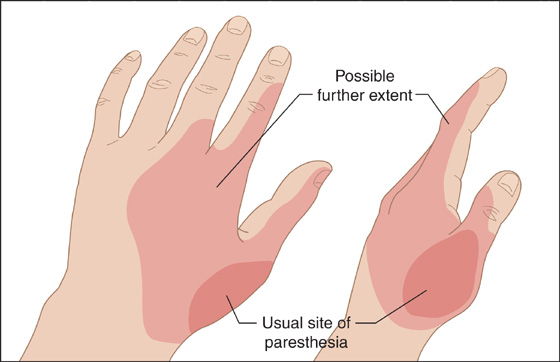CHAPTER 104
Cheiralgia Paresthetica
(Handcuff Neuropathy)
Presentation
The patient may complain of pain around the thumb caused by tight handcuffs. The pain decreases with handcuff removal, but there is residual paresthesia or decreased sensation over the radial side of the thumb metacarpal (or a more extensive distribution). Pulling on a ligature around the wrist or wearing a tight watchband may also produce the same injury.
What To Do:
 Carefully examine and document the motor and sensory function of the hand. Draw the area of paresthesia or decreased sensation as demonstrated by light touch or two-point discrimination. Document that there is no weakness or area of complete anesthesia.
Carefully examine and document the motor and sensory function of the hand. Draw the area of paresthesia or decreased sensation as demonstrated by light touch or two-point discrimination. Document that there is no weakness or area of complete anesthesia.
 Explain to the patient that the nerve has been bruised and that its function should return as it regenerates, but that the process is slow, requiring about 2 months.
Explain to the patient that the nerve has been bruised and that its function should return as it regenerates, but that the process is slow, requiring about 2 months.
 Arrange for follow-up if needed. Bandages, splints, or physical therapy are usually not necessary.
Arrange for follow-up if needed. Bandages, splints, or physical therapy are usually not necessary.
What Not To Do:
 Do not overlook more extensive injuries, such as a complete transection of the nerve (with complete anesthesia) or more proximal radial nerve palsy (see Chapter 129). Do not forget alternative causes, such as peripheral neuropathy, de Quervain tenosynovitis (see Chapter 108), carpal tunnel syndrome (see Chapter 103), scaphoid fracture (see Chapter 130), or a gamekeeper’s thumb (see Chapter 135).
Do not overlook more extensive injuries, such as a complete transection of the nerve (with complete anesthesia) or more proximal radial nerve palsy (see Chapter 129). Do not forget alternative causes, such as peripheral neuropathy, de Quervain tenosynovitis (see Chapter 108), carpal tunnel syndrome (see Chapter 103), scaphoid fracture (see Chapter 130), or a gamekeeper’s thumb (see Chapter 135).
A superficial, sensory, cutaneous twig of the radial nerve is the branch most easily injured by constriction of the wrist. Its area of innervation can vary widely (Figure 104-1). Axonal regeneration of contused nerves proceeds at about 1 mm per day (or about an inch per month). Recovery may require 2 months (measuring from site of injury in wrist to end of area of paresthesia). Patients may want this injury documented as evidence of “police brutality,” but it can be a product of their own struggling as much as too-tight handcuffs.

Figure 104-1 Darkest shading shows the usual site of paresthesia. Lighter shading shows possible further extent.
Stay updated, free articles. Join our Telegram channel

Full access? Get Clinical Tree



